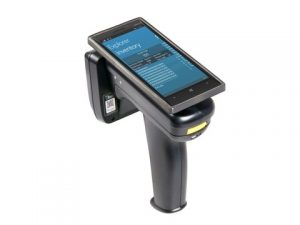What is RFID Pallet Tracking?
There’s been quite a buzz building about pallet order tracking – and RFID pallet tracking is one of the techniques used to track a pallet’s location.
Read on to learn more!
How Does RFID Tracking Work?
Radio-frequency identification utilizes electromagnetic fields to automatically identify and track tags attached to objects.The tags contain electronically stored information. This technology allows users (customers and vendors) to sort, track, identify any object they choose to tag. It is a very common practice in warehouses for distribution and tracking.
RFID System Overview
RFID systems consist of three components:
- RFID tag or smart label
- RFID reader
- Antenna

RFID Tag Reader
RFID Tags
RFID tags contain an integrated circuit and an antenna, which are used to transmit data to the RFID reader (also called an interrogator).
RFID Tags are available in two basic types: Active and Passive.
Active RFID Tags
Active RFID Tags contain a self-powered transmitter (frequently battery powered), allowing the an internal microchip’s circuitry to send a signal to the RFID Tag Reader.

Active RFID Tag
Passive RFID Tags
Passive tags are powered by the RFID Tag Reader. A magnetic field forms around the coiled antenna inside the passive tag in the presence of radio waves transmitted by the reader. The passive tag draws power from the magnetic field, energizing the tag circuits and completing the data transmission back to the tag reader.

Passive RFID Tag
RFID & ERP (Enterprise Resource Planning) Compatibility
ERP software can use RFID tracking to locate products and resources along their journey through supply chain, including both inbound and outbound delivery processes.
Why is this important? The locational visibility helps establish supplier transparency and accountability; furthermore, this also allows customers to track their items during shipment to drive greater customer satisfaction.
When a plastic pallet bearing an RFID tag reaches a particular location, the pallet can be processed using an automated receipt and validation of the advanced ship notice (ASN). This receipt can also mark and notify mistakes in the vendor fulfillment process, eliminating added labor and receiving resources that would normally be expended to correct the mistake.
With outbound deliveries, tagged pallets can be identified, notifying suppliers to contact their customers with the good news. After all, excellent communication is a superior service.
While the tagged item is stored at a plant, RFID tracking can be used to organize and pace maintenance processes, such as work orders. Work order phase and status data can be updated and saved on the tag to aid in throughput monitoring and production management.
RFID & Plastic Pallets
Does Tag Choice Matter?
Best practices reveal that robust RFID tags are the best fit for plastic pallets.
How Many RFID Tags Should I use?
Single tags are sufficient in systems that only use a handheld RFID reader. Plants using a gate system should consider using two tags to play it safe, in case one of the tags signals is blocked during transmission.
Plastic Pallet RFID Integration & Placement
RFID devices should be placed in a location that allows them to be read, but also in a secure spot that protects them from damage that would occur through handling.
Custom RFID – Do You Need It?
Custom RFID Advantages
Custom RFID printing always goes through a quoting and approval process, but a high level overview of our capabilities includes:
- Encoding RFID tags with your data.
- Printing/Encoding Barcodes to label your tags.
- Printing Images on your tags.
- Expedited Fulfillment is available.
What Do You Think?
Please leave your comments below and let us know how RFID pallet tracking has helped you rule your warehouse – or if you need assistance in taking the next step.
Shopping Plastic Pallets?
Contact us for assistance or to shop plastic pallets. Our pallet experts will help you find the perfect plastic pallet for the right price.
About Robin Kiefer
Robin Spencer Kiefer connects customers with solutions and products. Robin is the Digital Marketing Manager of One Way Solutions.





